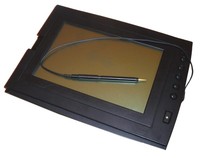GRidPad 1910
| Home > Browse Our Collection > Computers > GRiD > GRidPad 1910 |
|
The GRiDPad 1910 is the computer most commonly associated with the words "grid pad", AKA the brand name "GRiDPad", owned by GRiD. The first GRiDPad was introduced in 1989 The GRiDPad 1910 is basically an extremely portable PC-XT. It has a 640x400 backlit Monochrome touchscreen CGA display. It has 2MB of system memory, and often came equipped with a 20 MB 2.5" IDE disk. The pen system is capacitance-based, with a wired stylus. There is a 6-pin micro-DIN XT keyboard interface. Audio is limited to the usual PC Speaker support. There is one serial port expressed on the unit, and expansion for a modem, which came in 2400 and 9600 bps flavors. There are two ATA-FLASH slots on the unit, which are used strictly for storage. There is also an expansion bus connector on the bottom of the system, which includes at least a keyboard connector, a parallel port, and a floppy bus. There are buttons F1 through F5 and a sleep button on the unit, as well as a hard power switch. Power is supplied via Ni-Cad battery packs. This unit was used primarily for inventory purposes and the like. Apparently it was used within Chrysler for that purpose, and by the United States Army. The military specified more rigidity and durability from the case than the civilian version provided, and so GRiD made the case out of magnesium. They were never sold to the public that way, but occasionally a unit will slide out of the hands of the military. CPU NEC V20
RAM 2 MB Graphic modes 640x400 Colors 2 Sound PC speaker IO Capacitance-based wired pen Display: 24x80 LCD Hard Disk: 20mb Internal Ports: Serial: Parallel: Keyboard: Joystick: Expansion: PCMCIA v1.0, Docking Station The GRiDPad 1910 was manufactured by Samsung for the GRiD Systems Corporation
Our machine with a serial number of GPP05350 was very kindly donated by Andy Taylor of RetroComputers.Online Manufacturer: GRid Comment on This Page Other Systems Related To GRidPad 1910:
This exhibit has a reference ID of CH6565. Please quote this reference ID in any communication with the Centre for Computing History. |
|












